
Prepared on Notepad by Ian Smith,
This page created on 9th November 1998

The Forward Entrance Routemaster: RMF1254
RMF 1254 built on the success of the first batch of long Routemasters, RML880-903.
The major difference was that it had a forward doorway rather than an open platform,
with stairway behind the driver to match.
This was not a new arrangement for London Transport:
it had been used for two series of
Country STLs before the war.
What was new, and damnably significant from the Union point of view,
was that the front bulkhead had an angled window inserted to allow interaction between the driver and passengers.
This, and the secrecy of its construction, incensed the Unions,
who saw it not only as an attempt to introduce one man operation,
but with a totally unsuitable vehicle too.
The management ostensibly saw it as a way to allow the driver to oversee
boarding while the conductor was busy fare-collecting.
The upshot was that it never turned a wheel in ordinary revenue service for London Transport.
(PS: it eventually made its revenue-service debut in London in October 2005, when it worked on the last crew-day on the 38).
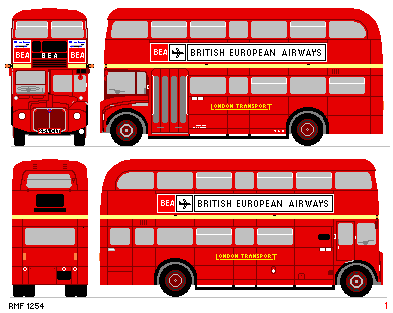
Construction
The body was fairly straightforwardly based on the RML design,
with the short 2ft 4in bay amidships.
A four-leaf electrically operated jack-knife door was fitted,
that partly recessed into the double entrance step when opened.
The staircase spiralled up clockwise,
delivering upward bound passengers onto the gangway upstairs.
There was a double seat forward of the stairwell,
and a single lateral seat behind it.
Two other single seats, forward facing,
were on the nearside oppsite the stairs.
A five-seater completed the rear on both decks.
Two more five-seater benches were situated over the rear wheel arches
on both sides downstairs. Total seating was 69, 38 upstairs, 31 down.
There was an emergency exit door on the rear offside,
behind the usual rear bulkhead position.
Displays were normal on front and rear,
with a route number under the canopy,
and an offside number window behind the driver.
There was no near-side display,
and no provision for slip-boards on the front bulkhead,
due to the angled window.
Ventilation was through a normal large grille opening and heat-exchanger
at the front (or opening windows).
There were small grilles above the rear top window,
and above the rear-most fixed windows on either side of the lower deck.
At the rear the lower saloon had a wide window,
with a pair of standard indicator flashers below.
The number plate and stop-light were shifted towards the offside
to make room for the battery box.
Mechanically it was very similar to the RMLs,
with the standard AEC AV590 engine and extended prop shaft.
The rear springs were rather stronger
to take account of the altered weight distribution.
Total unloaded weight was 7-14-2.
A detail innovation, perhaps indicating AEC's hopes of wider sales,
was the traditional AEC blue triangle at the top of the radiator,
replacing the LT bullseye on the bonnet.
Livery was standard London red with a cream band,
with blinds (never used in service) for the 104.
History
RMF1254 appeared for the 1962 Commercial Motor Show,
after which it was officially handed over to London Transport
and embarked on a series of demonstrator visits to other companies.
Perhaps LT never intended RMF 1254 for its own use,
but just as a loss-leader,
to try to recover some of the Routemaster development costs by selling them more widely.
Liverpool Corporation
Anyway, RMF 1254 went to Liverpool Corporation at the end of October 1962,
and stayed with them for four weeks,
before disappearing into Aldenham for the winter.
Perhaps that was the best place to be that winter!
East Kent
After the worst of the 1963 snows,
RMF 1254 was off to Canterbury for a fortnight in March with East Kent.
But by the beginning of April it was back in Aldenham.
For the next year it languished somewhat,
but acted as test-bed for the new range of frontal accessories for the RM family:
half-depth heater grilles, full-width cream band across the front,
deeper front valances without grille recesses...
BEA
Towards the end of the year its fashion-show phase was over,
and its rear end was fitted with a more workman-like accessory - a towball.
It followed RM8 onto the programme of trailer tests, on behalf of BEA
(British European airways).
With rear seat downstairs replaced by hand-luggage space,
and with trailer behind, RMF 1254 was paraded at Chiswick in January 1964.
But it was June before it was licensed for training,
and August before it started work alongside the
BEA RFs and an experimental Regent V
on the London- Heathrow shuttle.
Halifax CorporationAfter a fortnight in the new job it went on holiday again,
to the gritstone hills of Yorkshire.
Its two weeks with Halifax Corporation were another success that led to no order.
It was to be some years before Halifax saw RMs again.
Back to BEA
Then it was back to London and the Heathrow shuttle, for two years. This DID lead to orders,
with BEA acquiring standard-length forward entrance
RMA's for the work.
In October 1966 the non standard bus was withdrawn and taken into Chiswick,
prior to fitting with a Leyland engine and sale to Northern General.

Northern General RMFs
In Gateshead RMF 1254 found itself suddenly surrounded by siblings.
Its journeys to Liverpool, Kent and Halifax had produced no orders,
but one had come out of the blue from Northern General in 1963.
They needed some better-than-average buses for their faster inter-urban services,
especially those shared with United.
The latter used long Bristol FLF Lodekkas
which compared more than favorably with Northern's standard Atlanteans.
So Northern chose the long front-entrance Routemaster.
It received two batches: 18 in March 1964 and 32 later.
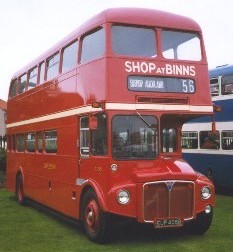
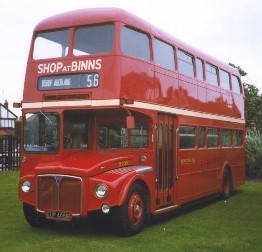
Northern General 2105 in preservation,
at Seaham, August 1998. Photos by Ian Smith. Click for larger versions
These RMFs were not identical to RMF 1254:
outside they showed no front opening windows,
either upstairs or in the cab
ans sported Northern's wonderful crimson lake livery.
There was no rear display,
and the front was a single window incorporating a destination blind
and a three-track number roller. Most had the usual "SHOP at BINNS"
sign-written on the front above the blind window.
Opening windows had horizontal sliders rather than vertical winders.
Mechanically they had differences too:
Leyland engines; a semi-automatic gearbox by Monocontrol;
a worm drive to the rear axle (5.2 - 1) and manual brake adjusters.
The first batch had fluorescent lighting and fairly traditional interior decor,
but the second batch, in 1965 had an interior designed in modern finishes of the day.
Outside they had the later finshes too
(many of them modelled first by RMF 1254):
half-depth heater inlet grilles and no brake vent grilles.
Both batches seated 72 (41/31).
RMF 1254 was modified in some ways to blend in when it arrived:
eg the destination blinds were changed to conform,
and it received standard livery and the inevtable Binns advert.
However, it retained its opening front windows,
both upstairs and in the cab,
and had the later, deeper front valances with no grille recesses.
It was renumbered, becoming 2145.
(The other batches had been 2085-2102 and 2103-2134.)
New liveries, numbers...
In 1969 thirteen of the Northern RMs were repainted in a cream and raspberry red livery,
and retained it for two years until the next repaint, when they reverted to the standard crimson lake with cream band.
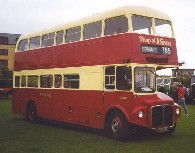
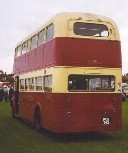
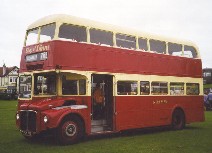
Northern General 2099 in preservation,
at Seaham, August 1998. Photos by Ian Smith. Click for larger versions
Standard NBC poppy red eventually overtook the RMs as well as the rest of the Northern fleet from 1972 onwards,
and all had succumbed by 1975.
The RMs were renumbered in a general fleet re-numbering in 1975,
becoming 3069-3118, with ex-RMF 1254 becoming 3129.
3129 also lost some of its winding windows at its 1975 overhaul,
and had the LT style spiral bevel rear drive replaced by a worm drive
from a withdrawn Northern RM the following year.
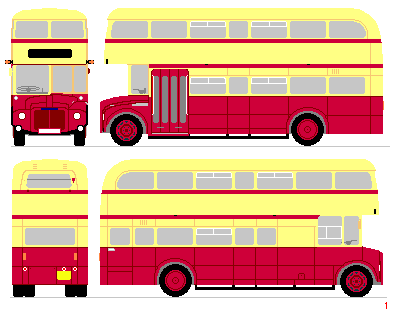
The Wearsider
(or weird-fronter)
No 2085 had a serious front end accident in 1972,
as a result of which the drivers position and staircase
were moved backwards by 30 inches.
It was not the accident that did this,
but it did provide an excuse for the experiment!
This put the driver alongside the door, to enable one person operation.
It did not improve the looks of the RM! This peculiar machine,
named the Wearsider,
operated in opo mode for a while,
then reverted to crewed duties on a spasmodic basis.
Withdrawal, Preservation and London Transport.
The Northern General fleet stayed in service until 1977
(except 3093, which suffered a bad prang in 1976),
and then began to be withdrawn.
By December 1980 all had gone.
The Wearsider went in 1978, RMF 1254 in October 1980.
The last was 3105 (2121),
which was withdrawn with a press -call on 16th December 1980.
Some went to preservation, others went to dealers.
Two went to London Transport in January 1978,
who broke them for spares at Wombwell diesels.
London Transport bought a further seven from Brakell's during 1979.
It also acquired four more direct from Northern General, and one from Ensign.
LT put them all into store along with the various RM types
being bought from London Country.
Two were taken to Aldenham in January 1980 for assessment of the work needed
to put them back into passenger service in London.
The assessment was sufficiently discouraging to kill off the idea.
It was not major problems with the buses,
but minor differences from the standard fleet, that mattered.
Every difference, whether it was maintaining the worm differential
or having to go upstairs to change the rear blind,
was going to be more hassle than it was worth in the tricky state of labour relations then prevailing.
So although the twelve buses received London Transport fleet numbers
(RMF2761-2772), none ever ran in service.
London Sightseeing
A more interesting fate befell some that went to London,
where Obsolete Fleet and Brakell hired them to London Transport
for use on the Sightseeing Tours.
These were 3103, 3091, 3090, and 3102
which were given London running numbers RMF2791-4 respectively.
They operated the London Sightseeing Tours for several seasons,
alongside a medley of other types including ex-Midland Red D9s.
Three operable Brakell buses were offered for sale to LT in February 1980,
but the offer was declined.
RMT2793 (2106) (3090)
One of the tourers, RMF2793 (EUP406B), passed on from Obsolete Fleet
to a private owner who converted it to open-top.
As RMT2793 it was hired by the Commercial Operations Unit in summer 1986.
This unit, later to become London Coaches, had regrasped the reins of the Sightseeing business
with a batch of overhauled and repainted RMs, including some open-toppers.
These were so popular that the Unit first hired RMT2794 to augment them during the 1986 season,
then purchased it (by barter) in 1987.
It was refurbished and fitted with an RMC style front blind aperture,
and modern-style deep front valances.
The Big Bus Company
Three of the Northern General buses were obtained by the Big Bus Company
for London Sightseeing work, after various adventures with other operators.
They were 2118 (FPT 588C), 2122 (FPT 592C) and 2133 (FPT 603C).
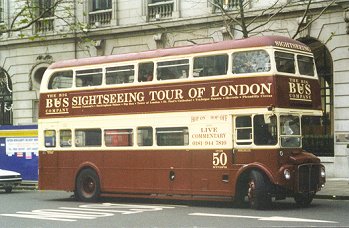
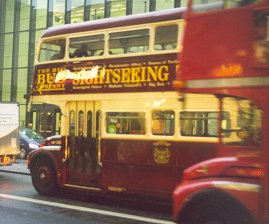
Big Bus RMFs operate on their London Tour services. One is seen at Aldwych early one Saturday morning in December 1998,
while 592 slips along through The Strand traffic one late afternoon in December 2002.

Survivors
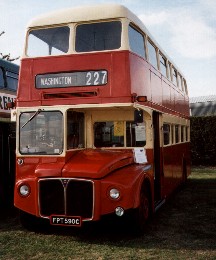
RMF1254 254 CLT 2145 3129 preserved
RCN 689 2089 3073 Fish & Chip shop, Falkenberg
RCN 699 2099 3083 preserved (now PCN762)
RMF2771 RCN 701 2101 3085 Guernsey's Barbados Party Bus
EUP405B 2105 3089 preserved
FPT580C 2110 3094 open-top, Belgium
FPT581C 2111 3095 Bertie Bus Co, Gloucester
FPT588C 2118 3102 Cancu Bus Service, Malta
FPT589C 2119 3103 advert for disco, Spain
FPT590C 2120 3104 preserved
FPT591C 2121 3105 Finland
FPT592C 2122 3106 ex-Big Bus Co
FPT603C 2133 3117 Autocar, Tonbridge: events bus
Preserved Northern General 2120, at Showbus 97.
Photo by Ian Smith. Click for larger version.

Bus Histories are on a separate page.
Photographic References are too.
 Ian's Bus Stop
Ian's Bus Stop
 RM Contents.
RM Contents.
 RMLs.
RMLs.
 RMFs.
RMFs.
 RMAs.
RMAs.
|

